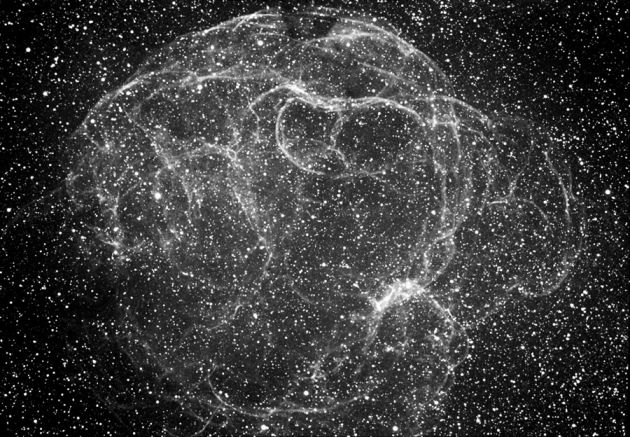
|
Credit & Copyright: Steve Mandel
Explanation:
It's easy to get lost following the intricate filaments in this
stunningly
detailed image of faint
supernova remnant Simeis 147.
Seen towards the constellation Taurus
it covers nearly 3 degrees (6
full moons) on the sky corresponding to a width of 150 light-years at
the stellar debris cloud's estimated distance of 3,000 light-years.
On three separate nights in December 2001 and January 2002
astronomer
Steve Mandel accumulated a total of over eight hours of exposure time to
compose this image.
He used an astronomical CCD camera, telephoto lens,
and his specially designed adapter to allow such
wide-field
digital imaging.
He also used a narrow H-alpha
filter to transmit only the
the light from recombining hydrogen atoms in the expanding
nebulosity, defining the regions of
shocked, glowing gas.
This supernova remnant has an apparent age of about 100,000 years
(light from the original explosion first reached Earth 100,000 years
ago) but it is not the only
aftermath of the massive stellar explosion.
The cosmic catastrophe also left behind
a spinning neutron star or pulsar,
all
that remains of the star's dense core.
|
January February March April May June July August September October November December |
| ||||||||||||||||||||||||||||||||||||||||||||||||
NASA Web Site Statements, Warnings, and Disclaimers
NASA Official: Jay Norris. Specific rights apply.
A service of: LHEA at NASA / GSFC
& Michigan Tech. U.
Based on Astronomy Picture
Of the Day
Publications with keywords: supernova remnant - H-alpha
Publications with words: supernova remnant - H-alpha
See also:
- APOD: 2025 June 9 Á Between Scylla and Charybdis: A Double Cosmic Discovery
- Supernova Remnant Cassiopeia A
- APOD: 2025 January 8 Á Supernova Remnants Big and Small
- APOD: 2024 September 18 Á The Mermaid Nebula Supernova Remnant
- APOD: 2024 April 16 Á Filaments of the Vela Supernova Remnant
- APOD: 2024 April 3 Á Unusual Nebula Pa 30
- APOD: 2024 March 25 Á Sonified: The Jellyfish Nebula Supernova Remnant
